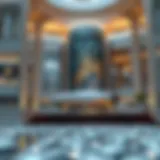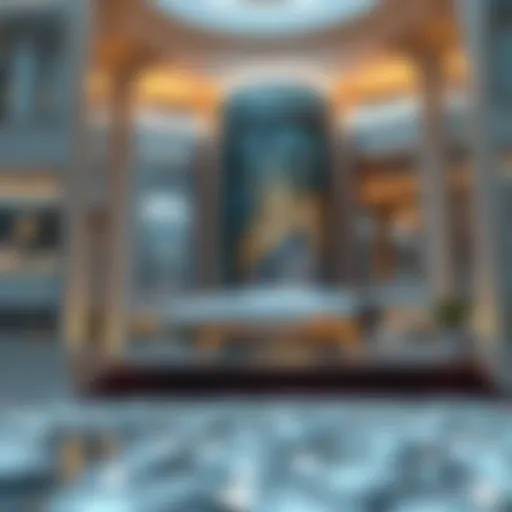The Curve Building: A Modern Architectural Icon on Sheikh Zayed Road
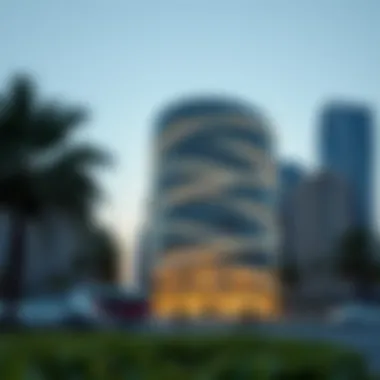

Intro
As Dubai continues to evolve into a beacon of architectural innovation, the Curve Building emerges as a shining example of modern design. Located prominently along Sheikh Zayed Road, this striking structure not only redefines the city's skyline but also encapsulates the spirit of aspirational urban living. With its fluid lines and thoughtfully planned spaces, the Curve Building is a testament to what can be achieved when creativity meets functionality.
By taking a closer look at this architectural marvel, we uncover not only its aesthetic delights but also its profound impact on the surrounding real estate landscape. This article aims to provide a comprehensive view of the Curve Building's significance, ranging from design principles to its implications on the local property market. It serves as an indispensable guide for investors, buyers, agents, and developers keen to understand the nuances of this distinct locale.
In exploring the Curve Building, we will dissect current market trends and neighborhood insights, shedding light on how this landmark has influenced property values and the dynamics of the area. Whether you’re contemplating a purchase or simply seeking to remain informed about the latest developments in Dubai's architectural scene, understanding the relevance of the Curve Building will provide you with the insights you need in this fast-paced market.
Next, we’ll delve into a property market overview that elucidates the positioning of the Curve Building within the broader context of the real estate landscape along Sheikh Zayed Road.
Intro to the Curve Building
The Curve Building, nestled prominently along the bustling Sheikh Zayed Road in Dubai, represents not just a feat of engineering but a chapter in the intricate story of modern architecture. This landmark serves as a nexus for various influences—be it cultural, economic, or social. For investors, buyers, agents, developers, and sellers, understanding the nuances of this structure is essential, as it impacts more than just the skyline.
Overview of Sheikh Zayed Road
Sheikh Zayed Road, often dubbed the lifeblood of Dubai, is a vivacious thoroughfare that weaves through the heart of the emirate. Stretching over 55 kilometers, this road is flanked with high-rises, luxury hotels, and vibrant commercial hubs. The sheer variety of architectural aesthetics along Sheikh Zayed Road reflects the evolution of Dubai's identity—from traditional designs to sleek, modern innovations. The presence of the Curve Building adds a new layer of visual interest and character, making this road a live canvas of urban artistry.
The road isn’t just a transportation route; it also stands as a testament to growth and ambition. The multitude of skyscrapers lining its path indicates a constant upward trend in urban development. As such, each structure, including the Curve Building, positions itself as a critical player in the narrative of Dubai's architectural progression.
Significance of Modern Architecture in Dubai
Modern architecture in Dubai is a reflection of its rapid transformation from a desert city to a global hub. Structures like the Curve Building play a pivotal role in this evolution, showcasing innovative design principles and sustainable technologies that resonate with contemporary global trends. They symbolize aspirations and ideals, capturing the essence of a city obsessed with progress and expansion.
The significance lies not only in how these buildings look but also in what they represent—an image of Dubai as a leader in innovation. The Curve Building integrates advanced construction techniques with environmentally-friendly practices, setting an example for future architectural endeavors. This forward-thinking attitude attracts both local and international investors who recognize the promise of sustainable and modern living spaces.
Furthermore, the influence of modern architecture extends beyond aesthetics. It plays a critical role in urban planning and the socio-economic fabric of Dubai. Investment in such projects boosts local economies, creates jobs, and enhances the overall quality of life for residents and visitors alike.
"Modern architecture in Dubai isn’t merely about the structures—it’s fundamentally about shaping the ethos of a global city."
With the Curve Building as a striking example, the city continues to forge a narrative that resonates with innovation and ambition. This makes understanding such landmarks not only interesting but essential for engaging with Dubai's real estate market. The modern architectural landscape is dynamic, and to capitalize on investment opportunities, one must keep an eye on these architectural milestones.
Design and Architecture
The design and architecture of the Curve Building reflect more than just aesthetic choices; they embody principles that drive urban innovation in Dubai. As a centerpiece along Sheikh Zayed Road, its architectural significance is not only visually striking but also functional. This section delves into the core aspects of its design, unveiling how they contribute to the broader landscape of modern architecture in one of the world's most vibrant cities.
Architectural Features of the Curve Building
The Curve Building is an exemplar of contemporary design, blending form and function seamlessly. From the moment you approach it, the edifice commands attention with its distinctive curvature that rises fluidly into the skyline. The building's façade is not just attractive but deliberately engineered to optimize natural light, while minimizing heat gain. Additionally, the use of transparent and reflective materials creates a dialogue between the structure and its surroundings, allowing it to harmoniously interact with the sun's trajectory throughout the day.
Key architectural features include:
- Dynamic Shape: The curve symbolizes movement and progress, which is fitting for a city like Dubai, renowned for its rapid development.
- Sky Gardens: These green spaces, integrated at various levels, not only enhance aesthetic appeal but also support biodiversity and offer residents a slice of nature amidst urban hustle.
- Innovative Layouts: The interior configurations are thoughtfully arranged, promoting open, airy spaces that foster collaboration and interaction among occupants.
"The Curve Building redefines what it means to occupy space in a modern urban environment, forging a new paradigm in architectural design."
Materials and Technology Used
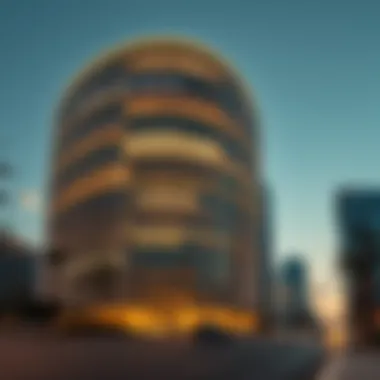

In building the Curve, a meticulous selection of materials and cutting-edge technologies were employed to achieve both durability and elegance. Glass and steel dominate the structure, reflecting modernity while being operationally efficient. The glass used is treated for thermal performance, ensuring that the interiors remain comfortable irrespective of the relentless desert climate.
The technological innovations incorporated into the Curve Building include:
- Smart Building Systems: Advanced energy management systems control lighting and climate, significantly reducing overall energy consumption.
- High-Performance Insulation: The incorporation of superior insulation materials not only enhances comfort but also curbs energy usage.
- Modular Construction Techniques: This allowed for a quicker and more efficient build while maintaining high standards of craftsmanship.
Sustainability Features and Innovations
Sustainability isn't just an afterthought in the Curve Building; it is foundational to its very existence. The design integrates various eco-friendly elements geared towards minimizing the building's environmental impact. This aspect is vital given the ongoing global shift toward sustainable urban development.
Among the sustainability features are:
- Rainwater Harvesting: A system designed to collect and utilize rainwater helps in watering the gardens and landscape, reducing the reliance on municipal water.
- Solar Panels: Strategically placed solar panels provide renewable energy, contributing to the building's energy efficiency.
- Green Certification: The building is expected to achieve LEED certification, a recognition that attests to its sustainable design and operation.
In sum, the design and architecture of the Curve Building not only set a new benchmark for aesthetic and functional design in Dubai but also forge a sustainable path for future developments. The careful integration of architectural elegance, advanced technology, and eco-friendly practices positions this building as a landmark of modern architecture.
Location Analysis
Location is often regarded as the cornerstone of any successful real estate venture, and this is especially true in the context of the Curve Building on Sheikh Zayed Road. The significance of its positioning along one of Dubai's most important thoroughfares cannot be underestimated. It's not merely about being seen from the highway; it’s about being situated in a vibrant, bustling area that attracts businesses, tourists, and residents alike. The strategic placement of the Curve Building contributes immensely to its status as a landmark, offering both visual appeal and practical advantages.
Strategic Positioning Along Sheikh Zayed Road
Sheikh Zayed Road itself is a central artery of Dubai, running through the heart of the city. It connects key districts, including Downtown Dubai, Dubai Marina, and Jumeirah, making it a vital transit point for both local commuters and international visitors. The Curve Building’s location here places it in proximity to several significant landmarks, including the Burj Khalifa and the Dubai Mall. This visibility enhances its attractiveness to potential tenants and buyers.
Real estate agencies often emphasize the value of visibility when pitching properties. The Curve Building benefits from constant exposure to vehicular traffic that can be counted in the thousands daily, creating opportunities for businesses within to leverage foot and mobile traffic in ways that are simply not possible elsewhere.
Furthermore, the architectural silhouette of the Curve Building adds a modern twist to the Dubai skyline, making it an instant recognizable feature for those traversing the busy road. This unique aspect acts as a purposeful draw for retail spaces within the building, providing businesses with a built-in marketing advantage.
Accessibility and Connectivity
When it comes to a successful commercial space, accessibility is paramount. The Curve Building's location allows for easy access to key transportation links, including the Dubai Metro and major bus routes. The Metro station, located just a brief walk away, enhances public transit access, making it easy for employees and customers alike to reach the building without the need for a private vehicle.
Additionally, the intertwined road networks around Sheikh Zayed Road facilitate smooth traffic flow, which is essential in a rapidly growing metropolis. Uber and Careem, two popular ride-hailing services, have also made reaching the Curve Building a breeze for anyone who prefers a more personalized travel experience from various parts of the city.
Moreover, as Dubai continues to evolve, future plans for infrastructure improvements along Sheikh Zayed Road further promise to enhance connectivity even more. Long-term infrastructure projects aim to improve transport networks and create pedestrian-friendly environments. This likely means that the accessibility of the Curve Building will only increase, adding more value to its real estate potential.
In summary, the strategic location along Sheikh Zayed Road combined with superior accessibility makes the Curve Building not just a remarkable architectural feat, but also a lucrative investment opportunity. The synergy of its position contributes to fostering a conducive environment for business growth and urban development.
Economic Impact
The economic implications of the Curve Building stretch beyond its physical presence along Sheikh Zayed Road. It embodies the essence of a thriving urban economic ecosystem, influencing various sectors within the local market. Not only does it contribute to Dubai's skyline, but it also plays a pivotal role in elevating the economic potential of its surroundings. The Curve Building serves as a key driver of commercial activity, attracting business investments and creating opportunities for local employment.
Influence on Local Real Estate Market
The Curve Building’s modern design has undeniably reshaped the local real estate market. Prior to its completion, this stretch of Sheikh Zayed Road was already recognized for its prestigious developments. However, the Curve Building’s distinctive architecture and strategic location have provided an impetus for escalating property values in the vicinity. Following its unveiling, surrounding properties witnessed not just a rise in demand, but also an enhancement in its perceived marketability.
Consider the following impacts as a result of the Curve Building:
- Increase in Property Prices: Just like a ripple effect, the Curve Building has caused adjacent properties to see a significant uptick in prices. Buyers are now willing to pay a premium for proximity to such a landmark.
- Attraction of High-Profile Tenants: With its status confirmed, the Curve has become a magnet for reputable companies looking for prestigious office spaces, thereby elevating the profile of the whole area.
- Boosting Commercial Footfall: Thanks to its architectural significance, the building draws a steady stream of visitors and professionals, which in turn fosters greater commercial activities in local establishments.


The allure of modernity mixed with versatility appeals to a variety of businesses, making the Curve Building a pivotal cog in the local real estate machinery.
Market Value Trends Associated with the Curve Building
The market trends associated with the Curve Building reveal several noteworthy patterns that reflect its impact on the region's economic landscape. Investors and potential buyers are increasingly tuning into these trends, which could serve as fundamental indicators for future decisions.
- Rising Rent Costs: Data shows that rental rates in buildings close to the Curve have increased sharply. The building’s prestige creates a pull for businesses that wish to have a corporate address that resonates with modern sophistication.
- Higher Return on Investment: Investors examining properties in proximity to the Curve are likely noticing enhanced returns compared to older developments. As the building becomes a draw on the market, prices are expected to remain robust.
- Shift in Buyer Demographics: There’s been a marked shift in the buyer demographics, with more affluent individuals and international companies showing interest—a sure sign of the building’s rising status.
As we analyze these trends, it’s evident that the Curve Building doesn’t just modify its immediate surroundings; it alters the economic landscape of Dubai. By pulling in economic interest and promoting growth, it establishes itself as a crucial player in the development story of Sheikh Zayed Road.
"The Curve Building is not merely an architectural monument; it's a testament to economic vitality, positioning itself as a catalyst for real estate evolution and growth in Dubai."
In the next sections, it will be essential to explore how these economic factors intertwine with cultural and social relevance, further solidifying the building’s comprehensive impact.
Cultural and Social Relevance
The Curve Building is not just an architectural feat; it represents a cultural beacon within the bustling heart of Dubai. Being situated on Sheikh Zayed Road, its design and presence serve as a reflection of the city’s aspirations and collective identity. As it rises gracefully against the skyline, it provides insights into how modern architecture interacts with cultural narratives, local values, and the aspirations of a rapidly evolving society.
Understanding the cultural relevance of the Curve Building involves looking at several elements:
- Architectural Identity: The curvilinear shape of the building distinguishes it from more traditional structures. This uniqueness symbolizes the innovative spirit of Dubai and encourages a dialogue about what defines modern architecture in an urban context.
- Cultural Gatherings: It has become a venue for social events and community activities. This helps foster a sense of belonging among residents and visitors alike.
- Local History and Heritage: Though it embodies modernity, the Curve Building also incorporates subtle elements that pay homage to the traditional cultural heritage of the UAE.
In the following subsections, we will delve deeper into what the Curve Building means as a cultural landmark and the ways in which it engages with the community.
The Curve Building as a Cultural Landmark
The Curve Building stands tall as a visual landmark along Sheikh Zayed Road. Its design transcends mere functionality, instead inviting locals and tourists to savor its aesthetic appeal. Beyond visual impact, it serves as a physical embodiment of innovation and creativity.
Locals often refer to it as an icon, much like the Burj Khalifa or the Dubai Mall. The building hosts various art installations and collaborates with local artists, further anchoring itself to the cultural fabric of the city. Its lighting design, which changes according to seasons or significant events, creates a dynamic presence that resonates with the community. The Curve Building encourages an appreciation for art and architecture, making it a destination for cultural expression.
Public Reception and Community Engagement
The reception of the Curve Building within the community has been predominantly positive. Many commend its striking design, viewing it as a symbol of progress and innovation. Community engagement activities, such as open houses or exhibitions, allow the public to connect with the space in meaningful ways.
Key Points of Engagement:
- Workshops and Classes: Regularly organized workshops help educate community members about sustainable architecture and design principles. These initiatives foster a greater understanding of the importance of eco-friendly practices in urban settings.
- Collaborations with Local Organizations: The Curve Building has partnered with schools and cultural organizations, laying the groundwork for educational programs that elevate community participation in art and architecture.
- Social Media Presence: The building has a growing presence on platforms like Facebook and Instagram, where the community shares experiences and engages in discussions about its role in the city's landscape. This digital engagement has helped build a sense of community and connectedness.
"The Curve Building is more than an architectural marvel; it's a testament to our collective values and ambitions for a sustainable future."
In summary, the Curve Building's cultural and social significance cannot be overstated. As it stands proudly on Sheikh Zayed Road, it encapsulates what is possible when innovative design meets community and tradition.
Comparative Analysis
Comparative analysis serves as a vital method of understanding a structure's impact within its architectural and cultural context. In the case of the Curve Building, this approach allows stakeholders to recognize its unique attributes while also situating it among other landmark edifices. By examining similarities and differences, investors, buyers, agents, developers, and sellers can glean insights that help inform their decisions regarding real estate ventures in Dubai's dynamic landscape. Moreover, a well-rounded comparison can provide contextualized perspectives that resonate with potential clientele, thereby enhancing their appreciation for the Curve Building's significance.
Comparing the Curve Building with Other Landmark Structures
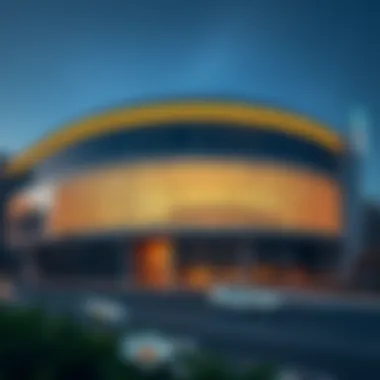

When looking at the Curve Building, one can’t help but draw parallels with other iconic structures like the Burj Khalifa and the Museum of the Future. Each of these buildings offers a distinct flavor of modern architecture while collectively contributing to Dubai's skyline.
- Burj Khalifa: As the tallest building in the world, the Burj Khalifa boasts an impressive height that captures global attention. In contrast, the Curve Building utilizes its distinctive shape and innovative design to stand out, showcasing architectural creativity rather than size alone.
- Museum of the Future: This building is celebrated for its futuristic design and meaningful use of Islamic motifs. Similarly, the Curve Building incorporates elements of local culture but does so through a more fluid, organic form that reflects the city's progressive narrative.
- One Za'abeel: This smarter-than-your-average skyscraper matches the Curve Building in its ambition towards sustainable design. However, the Curve Building emphasizes curved lines and innovative green technologies to create a symbiotic relationship with the environment, setting it apart from its competitors.
A detailed comparison highlights how each of these structures fulfills different urban roles and aspirations, ensuring a rich architectural discourse that showcases the unique essence of the Curve Building.
Lessons Learned from Similar Projects
Investigating the successes and failures of similar architectural projects provides crucial insights into potential future ventures. By understanding the trajectories of other landmark developments, stakeholders can better navigate the complexities of the real estate market.
- Sustainability is Key: Projects like the Edge in Amsterdam demonstrate that integrating renewable energy solutions can elevate a structure’s appeal. The Curve Building's commitment to sustainability aligns with this trend, ensuring it attracts environmentally conscious investors.
- Cultural Sensitivity Matters: The King Abdulaziz Center for World Culture's design is a testament to the importance of reflecting local heritage. Learning from projects like this, the Curve Building embraces aspects of Emirati culture while pushing the envelope of modern aesthetics.
- Community Integration: Structures designed with a focus on community engagement tend to foster stronger connections with the public. The Curve Building, with its mixed-use spaces and social areas, echoes lessons from the High Line in New York City, proving that urban revitalization can be achieved through thoughtful design.
Understanding these lessons equips stakeholders with a tools to make informed decisions about future developments within Dubai's ever-evolving architectural landscape.
Future Developments
Considering the trajectory of urban growth in Dubai, it’s essential to dissect future developments around the Curve Building and Sheikh Zayed Road. As this region continues to morph into a nexus of activity, understanding the potential plans helps investors and developers gauge opportunities.
Potential for Expansion and New Projects
The Curve Building is not only a statement of modern architecture; it is also a catalyst for further construction along Sheikh Zayed Road. With land values steadily ascending, there’s ample motivation for developers to look toward expansion. Key areas of interest include:
- Mixed-Use Complexes: The demand for multifunctional space is burgeoning. Potential projects could blend residential and commercial units, catering to growing populations seeking convenience.
- Cultural Institutions: Plans for museums or art galleries could enhance the cultural fabric of the area. These could draw tourists and locals alike, further stimulating economic activity.
- Public Spaces: Expanding green areas and leisure facilities can enhance the livability of the area, attracting families and professionals, which in turn increases the local property market's allure.
A focal point for many of these developments will be their eco-friendliness. As the global call for sustainability grows louder, projects that echo these values, using renewable materials and technologies, are likely to receive greater attention from investors.
Vision for Sheikh Zayed Road's Urban Evolution
Sheikh Zayed Road stands at the threshold of an exciting evolution. The vision for the road's future includes enhancing its role as a vital artery of commerce and a symbol of urban sophistication. Fundamental elements to this vision include:
- Smart Infrastructure: The integration of smart technology into urban planning and infrastructure will enable real-time data utilization for traffic management, energy efficiency, and public safety. Smart buildings will play a crucial role, offering an automated experience for occupants and visitors.
- Transit-Oriented Development: With an eye on connectivity, enhancing public transit options between key points can significantly reduce traffic congestion. This means constructing new transit stations and linking them with existing networks to foster greater mobility.
- Community Integration: As the area continues to develop, ensuring local communities participate in these changes is paramount. Engaging residents and local businesses in planning can facilitate a sense of ownership and enhance communal identity, leading to a thriving urban environment.
"The future vision is to not only expand, but to ensure that every inch of the road contributes to the livelihood and experience of both its residents and visitors."
Epilogue and Reflections
The exploration of the Curve Building serves not just as a synopsis of architectural prowess but also a broader commentary on urban evolution. This building encapsulates a blend of innovation and tradition, representing what Dubai stands for today and what it can become tomorrow. The implications of such a structure stretch beyond mere aesthetics; they touch the socio-economic fabric of the city.
As Dubai continues to grow, the Curve Building acts as a catalyst for businesses and individuals looking to invest in the area. It’s not just about what the building looks like—it’s about everything it symbolizes. Modern architecture like this influences local amenities, boosts tourism, and enhances the city's global reputation.
Moreover, in an age where sustainability is paramount, the building's eco-friendly features serve as a model for future developments. Planners and constructors worldwide can learn and adapt strategies from this project, which underscores the importance of aligning aesthetics with functionality and environmental awareness.
Summary of Key Insights
- Architectural Significance: The Curve Building stands as an emblem of modern design principles that fuse form and function. Its unique silhouette and structure capture the essence of contemporary architecture in a city known for its skyline.
- Economic Dynamics: The building positively impacts nearby real estate values. Investors are increasingly keen on properties that not only offer space but also prestige. This phenomenon can be seen in rising property demands in the surrounding area.
- Cultural Contribution: The Curve Building contributes to the cultural fabric of Dubai, marking its territory as a focal point for community interaction and urban activities. It’s not merely a piece of real estate; it’s a societal asset.
- Sustainability Aspects: The facility's design provides a blueprint for eco-friendly architecture, with advancements in materials and technologies paving the way for more responsible construction practices in urban environments.
Final Thoughts on the Curve Building's Impact
Ultimately, the impacts of the Curve Building extend beyond the immediate vicinity of Sheikh Zayed Road. It signifies a transformative moment in the realm of architecture not only for Dubai but also for global standards. As urban landscapes become increasingly crowded, innovations exemplified by the Curve Building will play a crucial role in defining future city planning and development.
Decisions made today will affect the city’s ecosystems for years to come, and structures like this ensure that aesthetics, sustainability, and functionality walk hand in hand. The learning derived from the Curve Building is a guiding light for future ventures aiming to make a similar mark on global urban architecture.
"In every corner of the world, as cities evolve, it's the bold visions like the Curve Building that set the stage for tomorrow's landscape."
Investors, developers, and urban planners are advised to keep an eye on such landmark structures as they redefine not only the skyline but also the societal values inherent in urban growth.






